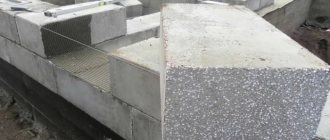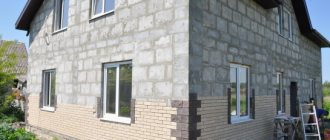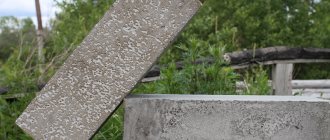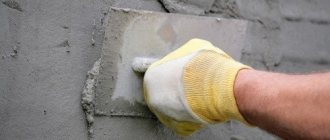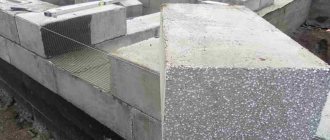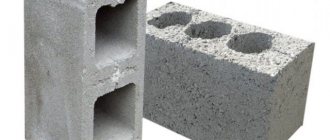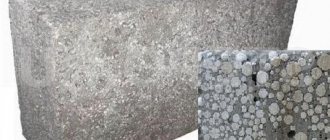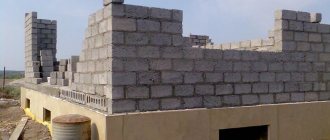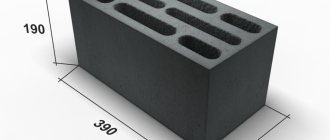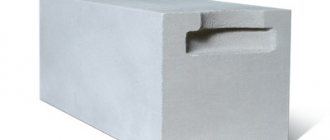If you ask a random person to list the popular materials for building a house, most likely the first options will be wood and brick. This has been the case for many centuries, but in the last fifty years a lot has changed. Thanks to the development of construction technologies, building materials with new properties have appeared; one of them was called polystyrene concrete.
Initially, the material was not widespread (due to the high cost of raw materials). In the late 60s, it was possible to improve the technological process and reduce costs. From this moment on, polystyrene concrete blocks (PSB blocks) have become a popular material, especially in demand in suburban low-rise construction. Today, the largest consumers of this inexpensive and practical building material are Germany, France, the USA and Canada.
Ready-made polystyrene concrete blocks Source krsk.au.ru
Polystyrene concrete: getting to know the material
Polystyrene concrete is a composite (complex in composition) material belonging to the class of lightweight concrete. Lightweight concrete has a reduced density, which allows solving several construction problems:
- reduce the weight of the building;
- increase its thermal insulation characteristics;
- reduce the cost of construction (by reducing labor costs and increasing the productivity of builders).
For the production of polystyrene concrete the following is used:
- Portland cement (a type of cement);
- water;
- polystyrene, filler in the form of granules of various fractions with heat-insulating properties (polystyrene is a polymer with a wide range of uses);
- quartz sand;
- plasticizers - various additives (for example, resin) that improve the plasticity of the mixture; Thanks to this, the blocks do not crack during hardening and drying.
Polymer granules (very similar to foam balls) create the lightweight structure of polystyrene concrete. The low density of foam and aerated concrete is ensured by air pores resulting from a chemical reaction.
Polystyrene granules Source archidea.com.ua
Research and development work
In order to significantly reduce the cost of manufacturing polystyrene concrete tongue-and-groove slabs in proprietary universal multi-place cassette forms, the following has been developed:
- technology for manufacturing polystyrene concrete tongue-and-groove slabs in universal multi-place cassette forms with low cost ;
- equipment for implementing the technology for manufacturing polystyrene concrete tongue-and-groove slabs in universal multi-place cassette forms with low cost ;
The above technologies and equipment were developed at the stage of research and development work, development of working drawings of the equipment.
These technologies, equipment, construction mixture, special additives are planned to be introduced at the production sites of organizations that own the technology for manufacturing proprietary polystyrene concrete tongue-and-groove slabs in proprietary universal multi-place cassette forms.
These technologies, working drawings of equipment, construction mixture, special additives will be submitted for consideration exclusively to organizations that have acquired the rights to conduct production and commercial activities under the conditions specified in the section of this article “Copyright for the introduction of proprietary technologies and equipment into production and commercial activities on the territory of the Russian Federation and foreign countries.
Production methods
Polystyrene concrete products are produced in two ways:
- Handicraft (foundry). Popular among home craftsmen due to the availability of components and simple technology. The process is reminiscent of the production of non-autoclaved aerated concrete - the necessary components are mixed, the mixture is poured into molds and kept there until hardening (3-7 days). Injection molding technology is unprofitable in production (many labor-intensive operations for preparing and servicing molds).
- Vibrocompression (vibroforming). In industrial production, the mixture is mixed more concentrated (more cement, less water). It is loaded into molds and sent to a vibropress, where it is kept until semi-dry. When stripping, blocks with a clear geometry are obtained, which are then sent for final drying.
Polystyrene concrete with different densities is obtained by changing the ratio of components and the type of polystyrene granules (the larger the diameter of the polymer balls, the lower the specific gravity and strength of the material).
Pouring polystyrene concrete into molds Source beton-house.com
Disadvantages of homemade blocks
The presence of a concrete mixer and molds allows you to set up home production of PSB blocks. There are several comments regarding such products:
- Homemade production reduces the construction budget, but stretches the time.
- It is unknown what parameters the blocks will have, since the production process is poorly controlled.
- Homemade products will have low density.
- Inaccurate dosing will result in blocks that vary in quality.
- The products will have poor geometry, which will increase material consumption during laying.
The quality of the blocks will inevitably affect the quality of construction and durability of the house.
Polystyrene concrete – technology, compositions, formulation
As numerous reviews indicate, polystyrene concrete blocks are easy to make at home, mastering the technology, following the composition and recipe. Let us dwell on these issues in detail.
Proportions of ingredients and composition of polystyrene concrete
To ensure the required properties of a composite material, its composition must be observed. The following ingredients are used for production:
- Portland cement marked M400 and higher;
- fine-grained quartz sand;
- special additives that promote the formation of air cells;
- modifiers that increase the adhesion of cement to polystyrene granules;
- water added during the manufacturing process to the required consistency.
By changing the ratio of ingredients, expanded polystyrene concrete with different specific gravity is obtained, which is distinguished by its marking:
- To prepare a mixture of grade D200, you should use three bags of 400-grade Portland cement and 0.8 cubic meters of expanded polystyrene chips. 10 buckets of water are gradually added to the composition, and all components are thoroughly mixed;
- a mixture marked D300, characterized by increased density, is prepared using 250 kg of M400 cement, one cube of polystyrene granules with the addition of 120–130 liters of water.
The density of the manufactured polystyrene foam concrete is also determined by the size of the polystyrene granules, on which strength and thermal insulation depend. As the particle size increases, the specific gravity and strength characteristics decrease. The optimal size of polystyrene granules is 5 mm.
In order to obtain blocks from a self-mixed solution that are close in performance to the factory ones, a special installation is required
We make polystyrene foam blocks - what needs to be prepared
To prepare lightweight concrete mortar yourself, you need to prepare:
- concrete mixer used when mixing increased volumes of mortar;
- trough, for performing manual kneading;
- electric drill with a mixing attachment;
- shovels, buckets for loading ingredients and ready-made solution;
- forms in which polystyrene blocks will be made.
Having prepared the necessary ingredients and decided on the recipe, you can begin preparing the mixture.
We produce polystyrene concrete ourselves - work technology
It is not difficult to make polystyrene concrete yourself. The technology is similar to the process of making other types of concrete solutions. The production of expanded polystyrene concrete mortar consists of uniform mixing of the components.
The prepared mixture is used as follows:
- poured into molds intended for the production of foam and concrete blocks;
- loaded into frame formwork when pouring monolithic structures.
Technology for preparing a solution with polystyrene granules:
- Mix Portland cement with sifted sand in a concrete mixer or bucket.
- Fill in the sifted sand, gradually introduce polystyrene.
- Mix the ingredients until smooth, adding water.
- Add plasticizing agents and necessary additives.
When preparing the solution, it is necessary to ensure its uniform consistency.
Making polystyrene blocks - advice from professionals
Professional builders recommend:
- Grind the foam yourself to obtain granules. This will reduce costs, since ready-made polystyrene granules are expensive;
- perform a test batch before preparing the solution in large volumes. This will allow you to adjust the recipe and accurately determine the composition;
- use Portland cement with a marking of at least M400 for production. It will ensure the necessary strength of the composite.
Polystyrene concrete is a promising building material, which is advisable to use when carrying out construction and thermal insulation measures. Blocks made of foam plastic and concrete have high performance properties and can be made at home. If you decide to use purchased products, order them only from trusted manufacturers.
Pros and cons of polystyrene concrete blocks
When thinking about building a country house, many owners consider polystyrene concrete blocks as a building material, the pros and cons of which are determined by the granular structure of the material. The advantages include:
- Economical. The material captivates with its cheapness.
- Low thermal conductivity. Good thermal insulation properties make it possible not to install additional wall insulation with mineral wool or polystyrene foam.
Advantage of thermal efficiency of polystyrene concrete Source sevparitet.ru
See also: Catalog of companies that specialize in insulating houses.
- Low density and mass (compared to classic concrete). The load on the foundation is reduced (it can be made less massive), as well as the costs of transportation and masonry.
- Low water absorption (water is absorbed only by the surface) and, accordingly, low thermal conductivity, even in conditions of high humidity.
- Decent sound insulation.
- Treatment. PSB blocks lend themselves well to mechanical processing (they can be sawed and grooved without effort), which is valuable when laying communications.
- Frost resistance. GOST sets a minimum rate of 25 freeze-thaw cycles for structural materials used in the construction of external walls. The frost resistance of thermal insulation material is not standardized. In regions with cold winters, walls can be protected by insulating or plastering them.
- Environmentally friendly. Polystyrene, used in the production of polystyrene concrete, is used to make decorative ceiling moldings, toys and well-known yogurt cups. Harmful additives can get into the material during garage production.
One of the disadvantages of a polystyrene concrete block is poor adhesion to plaster Source beton-house.com
Like any material, polystyrene concrete also has disadvantages:
- Low compressive strength (used for the construction of buildings no more than two floors high). Windows and doors can become loose over time.
- Low vapor permeability. A wall made of polystyrene concrete will not breathe, which will inevitably affect the microclimate of the premises. To remove moisture, forced ventilation and air conditioning are needed.
- Flammability. The concrete frame of the blocks is not flammable, unlike the filler. Polystyrene decomposes when exposed to fire, which leads to a decrease in the strength and heat-shielding properties of the material.
- Fasteners In order for the swivel bracket (and with it the TV) to hold firmly in a wall made of polystyrene concrete blocks, anchors and dowels are needed that are specially designed for fastening into lightweight concrete.
The procedure for performing construction work
When installing a polystyrene concrete floor with your own hands, it is worth considering certain points. It is better to trust the professionals, but if you want to do it yourself, it is important to follow all installation steps.
Installation of floor slabs
Before installing the slabs, it is important to carry out the preparatory work:
- Clean the surface;
- Check for irregularities and correct if necessary;
- Build a base for laying the slab (from cement no more than 2 cm thick).
After this, fasten the slabs to the supporting structures as evenly and accurately as possible. If there are voids, fill with thermal insulation material.
To increase the reliability of the structure, a reinforced belt must be installed around the perimeter of the supports. It is a monolith, inside of which there is a frame made of reinforcement.
The reinforced belt will allow you to evenly distribute the load on the base; the slabs are laid on it only after curing sufficiently to achieve maximum strength.
After installing the slabs, check the evenness of the entire surface. If there is a difference in height, you need to reinstall the slab - increase or decrease the layer of concrete mortar.
In the case where floor slabs separate basement or attic spaces, an additional layer of insulation is required.
Installation of a monolithic floor slab
A monolithic ceiling is poured in the form of a solid slab onto a formwork base; corrugated sheeting is most often used for the base. You can do the filling yourself, or you can invite representatives of a company that provides this type of service.
It is worth considering that the process of installing a monolith takes a lot of time and consists of several stages. It is also important that the load-bearing walls of the building are designed to bear the load of such a slab.
Varieties
Construction standards (according to GOST R51253-99) provide for polystyrene concrete products of the following categories:
- Structural, marking D450-600.
- Structural and thermal insulation, grades D350 to D450.
- Thermal insulation, D150-350.
Types of PSB products Source nauka-i-religia.ru
PSB building blocks are also classified by size and method of use:
- Polystyrene concrete blocks for mounting external walls (structural) have a density of D500-D600 (500-600 kg/m3). Products with parameters 188x300x588 and 300x380x588 mm are produced industrially.
- The blocks used for organizing internal partitions (thermal insulation) have a density of D400 and sizes 92x300x588 and 92x600x588 mm.
- Reinforced lintels (to protect openings) with a density of D400 can have a length from 1200 to 3000 mm and various sections (140x235, 140x295, 180x235, 180x295 mm).
- Facing (decorative) products have a molded front surface, density from D300 and various sizes. A façade lined with such blocks does not require additional finishing (it can be painted if desired).
Areas of application
The areas of use of PSB blocks depend on the density of the material:
- In classical construction. Structural products are used for the construction of main walls and partitions. There are ordinary and reinforced (reinforced) PSB blocks.
PSB facing blocks Source isd-group.ru
- In monolithic construction (as thermal insulation). The material is used both in the form of blocks and in liquid form. The mixture is prepared directly on site and is used for screeding floors, insulating roofs, pouring floors, and filling frames. It is also used as fireproof coatings.
- As a finishing material. We produce PSB masonry blocks with a decorative front side (with cladding) and finishing panels for façade cladding.
- As thermal insulation (insulation). Low density thermal insulation boards are produced.
- During the construction of chimneys and ventilation ducts.
A little about quality
There are no problems with building a house from polystyrene concrete blocks - this is a common building material. To determine the quality of products, you must remember:
- High-quality products are equipped with a certificate that lists the characteristics of the material.
- The choice of product brand depends on the type of structure (residential building or outbuilding). The standard size of a regular PSB block is 188x300x588, a large one is 380x300x588 mm.
Low-quality polystyrene concrete blocks break with one blow Source beton-house.com
- The durable PSB block can withstand a fall from a height of 3-4 m or several blows with a sledgehammer.
- The granules on the cut of the material are clearly distinguishable, have the same size and are evenly spaced, adjacent to each other.
- The material must not have voids.
Stages of work
Formwork assembly
The formwork is a box into which the concrete solution will be poured. For construction, it is better to use wooden boards; they should be as smooth as possible. They are easier to assemble and dismantle, as well as process (cut, saw, adjust to the required dimensions).
Board sizes
- thickness – from 2 cm;
- height - depends on the thickness of the proposed slab; it should be several centimeters higher.
The boards are assembled into panels, which will form the basis of the side boards. The mass is very heavy and can push through the tree, so stiffening ribs must be installed every half meter.
Supports are installed under the formwork - one for each square meter. The supports must be strong, durable, and thick enough to support the weight of the concrete without deforming.
Reinforcement
Without installing reinforcement, the slab may crack; reinforcement helps it withstand the loads and weight of the building (pre-pouring the slab above the basement).
The reinforcement is installed in two layers - lower and upper. The lower mesh has more impact, so the rods should be thicker - at least 12 mm. For the top layer, you can take a thinner one.
The average size of one cell is from 15 cm to 20 cm, the rods are tied together with wire or welded. The frame is attached to the walls of the box; it must be securely installed.
The distance between layers of reinforcement is at least 10 cm; the reinforcement should not lie on the formwork. The layer of concrete under the reinforcement layer is at least two centimeters.
Pouring polystyrene concrete
A concrete solution is laid on the prepared base. It is important not to allow the mass to accumulate in one part, but to immediately distribute it evenly over the entire surface.
The thickness of the layer over the entire area should be the same; special jumpers installed before pouring will help to monitor this.
After spreading the concrete, you need to make the surface smooth using a rule or take a flat board.
A day later, we dismantle the formwork, cover the surface with film and leave it until completely dry for several weeks (the film can be removed after a couple of days). The thicker the layer, the longer it takes for the slab to dry.
Floors made of expanded polystyrene concrete are the optimal solution for building a house. The boards are light and durable, have high thermal insulation and moisture resistance. Construction work can be carried out all year round.
Construction of a cottage from PSB blocks
A house made of polystyrene concrete with an area of 100-120 m2 on two floors can be erected in approximately 3 months. The process goes through the following stages:
- Foundation. The total weight of the structure is small, so the foundation is made less massive. Filling the basement walls with liquid polystyrene concrete makes it truly dry and warm.
- Walling. The structure grows quickly, but the blocks require careful installation; A reinforcing mesh is laid on top of each row, increasing the rigidity of the structure. To prevent the formation of cold bridges, the thickness of the glue in the seams is kept to a minimum.
Pouring interfloor slab Source rmnt.net
- Floor and ceiling coverings. They are made from PSB blocks or filled with liquid mortar. Before screeding the floor, water distribution throughout the house is arranged.
- Roof and communications. Installed in accordance with the project.
- Exterior finishing. It is carried out taking into account the characteristics of polystyrene concrete. Decorative facade PSB blocks with a textured front surface or plaster are popular.
Cost of polystyrene concrete products
In general, the cost of PSB blocks is 10-15% higher than that of foam and aerated concrete analogues. The price of polystyrene concrete blocks is determined primarily by the size and grade of material (structural or thermal insulation). Products with decorative finishing are 20-30% more expensive than construction products.
For a block measuring 595x375x295 mm, the average price in the Moscow region (per 1 m3, excluding delivery costs, depending on the brand) is:
- D-250 - 3000-3200 rub.
- D-300 - 3300-3400 rub.
- D-350 — 3450-3550 rub.
- D-400 — 3650-3750 rub.
- D-450 — 3800-3850 rub.
- D-500 — 3750-3950 rub.
- D-600 - 4250-4300 rub.
Walls made of PSB blocks with cladding Source isd-group.ru
